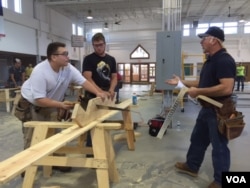As a union carpenter, Dustin Wolf used to walk on stilts to work on grid ceilings. Now he works for the local chapter of his union, Interior Systems Local 373 of the Regional Council of Carpenters, which represents 35,000 carpenters across Ohio, Indiana and Kentucky.
A fourth-generation union carpenter, Wolf will be voting for the Democratic presidential candidate because "the carpenters have endorsed Hillary Clinton, so that's who I'm voting for."
Wolf is part of a long tradition of union members voting for the candidate endorsed by their union. But there are signs that tradition may be changing.
Dustin's father works the phone banks for the union. A 43-year carpenter, Gary Wolf says he is "quite surprised" when some members tell him they are bucking the union and voting for Republican candidate Donald Trump.
Hard choice for members - and unions
It continues to be a tough economic time for union members, even as the U.S. economy has recovered in other sectors. Manufacturing and other union jobs continue to disappear and as a result, union membership nationwide has dropped. It peaked in 1979 at 21 million and stands now at 15 million.
The National Mining Association says 40,000 coal miners alone lost their jobs in the past year after the Environmental Protection Agency issued new emission standards.
United Mine Workers of America President Cecil Roberts said that kind of mass job disintegration left his members questioning the current Democratic administration.
"This election's tough for us at the very top because our people are so upset about losing their jobs over the course of the last few years," said Roberts. "And we don't have a recession in Appalachia. We have a straight-up depression."
Roberts' union has not endorsed either candidate yet, although both are clamoring for UMW votes as well as its phone banks and door-to-door voting programs. The union is torn between its longtime Democratic leaning and the anger of its members.
"The people are angry in the coal fields of West Virginia," Roberts said. "They're angry in the coal fields of Pennsylvania and Ohio and in the coal fields of Alabama. So it's a difficult proposition with the election for president, there's no question about that."
Political science professor Emeritus with Ohio State University Herb Asher said Republican candidate Donald Trump is saying what union members want to hear.
"I would argue that Trump's promises to bring back the coal jobs is without any credibility," he said. "But at least he's saying, 'We're going to bring back your jobs.' What did Hillary Clinton say? 'We're going to take away your jobs.' I think if those are the two choices, who are you going to vote for?"
Asher is the author of American Labor Unions in the Electoral Arena, which examines union voting influence.
As go union voters, so goes Ohio?
At age 33, Johnny Nickum is an apprentice carpenter. Nickum said he saw no future in the hospitality industry. So he switched to manual labor. And in November, he will defy the Regional Council of Carpenters' endorsement. "I'd probably vote Trump right now," he said.
Nickum is aware that unions are at a low point. But he doesn't think he's diluting their influence by taking a stand against his.
"You don't have to be a follower all the time. That's the best part of democracy ... being able to choose and think for yourself," he said.
How Nickum and other union members vote matters in Ohio, a key swing state in the presidential election that is a must-win for Trump. Ohio "remains critical to Mr. Trump's path to the White House," The New York Times recently observed.
But Ohio continues to be elusive, polling for Clinton in mid-August and Trump in mid-September. On Wednesday, two polls showed the state's voters were edging back toward Clinton in the wake of her strong performance in the first debate.
A Bloomberg Politics poll in mid-September showed union members were no more decided than the state as a whole. The poll indicated Trump was winning 45 percent of voters in union households, compared with 48 percent for Clinton.
But there are 670,000 workers represented by unions in Ohio. And their vote, whether they go along with union leadership or go it alone, could swing the state. President Barack Obama won the state by a little more than 166,000 votes in 2012.
A carpenter's considerations
Joe Ochsenhirt, 27, kneels down to drill a screw into a metal stud.
He graduated from Ohio University with a degree in business management but couldn't land a job in his field. Now he's a third-year apprentice union carpenter at the Ohio Carpenters' Apprenticeship and Training Program in Richfield.
In the past, he's voted Republican. But this year, he says he would like to check the "undecided" box: "I don't agree with either side. So I'm right in the middle."

































